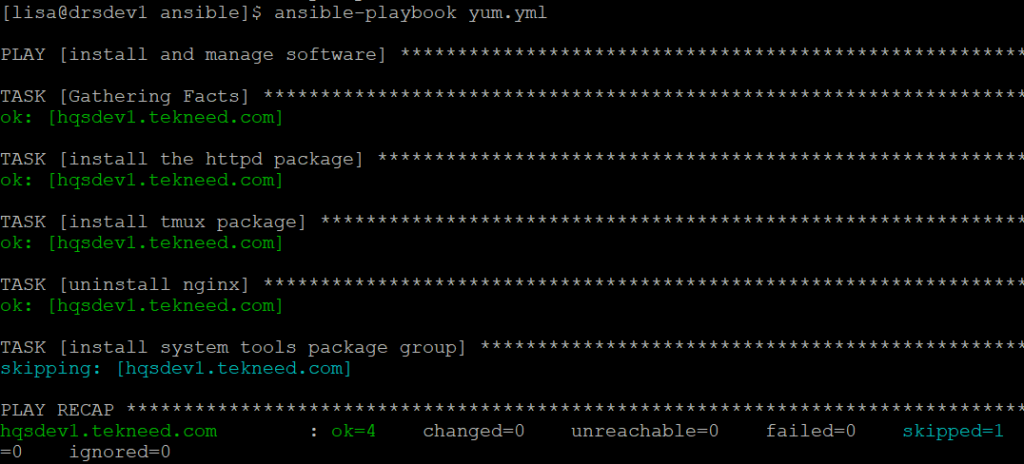
In this lesson, you will learn how to use the Ansible yum module and other types of software and subscription-related module to manage software and subscription in Linux.
Contents
- automating-software-processes-in-linux-with-ansible
- using-the-ansible-yum-module-with-examples
- using-the-ansible-dnf-module-with-examples
- using-ansible-loop-with-the-ansible-yum-dnf-module-with-examples
- using-the-ansible-package-module-with-examples
- managing-subscription-in-linux-using-ansible
- using-the-ansible-redhat_subscription-module-with-examples
- using-the-ansible-rhsm_repository-module-with-example
- using-the-ansible-yum_repository-module-with-examples
- including-and-importing-rpm-gpg-key-using-ansible
- using-the-ansible-rpm_key-module-with-example
Automating Software Processes In Linux With Ansible
Software, or rather packages, can be installed and managed or automated with Ansible. In this lesson, we will look at how to automate software processes using the Ansible yum module, Ansible dnf module, Ansible package module, etc.
Using the Ansible yum Module with examples
The Ansible yum module is used to manage packages/software; such as installation & un-installation of software, software updates, etc.
The manual page of the Ansible yum module can be displayed by using the command, “ansible-doc yum”.
Some of the important options of the yum module are present, absent, latest, etc.
Let’s look at what these options are used for.
*The Ansible yum Module present Option
The present option is used to install packages or software. If the package is already installed, it checks and makes sure the package is present.
*The Ansible yum Module absent Option
The absent option is used to uninstall or remove packages or software
*The Ansible yum Module latest Option
The latest option will make sure the packages or software has the latest version if it is already installed. If it is not already installed, Ansible installs the latest version of the packages or software.
The yum module can also be used to install package group. One can use the command, (yum group list) to see the lists of package group on the system.
Let’s see how the yum module can be used with some examples using the playbook below.
[lisa@drsdev1 ansible]$ vi yum.yml---
- name: install and manage software
hosts: hqsdev1.tekneed.com
tasks:
- name: install the httpd package
yum :
name: httpd
state: present
when: ansible_distribution == 'RedHat'
- name: install tmux package
yum:
name: tmux
state: latest
- name: uninstall nginx
yum:
name: nginx
state: absent
The playbook above will use the yum module to install the httpd package only when the managed hosts are Red Hat enterprise Linux.
Secondly, the latest version of tmux package will also be installed.
Thirdly, nginx will be removed from the managed host.
*Run the playbook.
[lisa@drsdev1 ansible]$ ansible-playbook yum.yml --syntax-check
playbook: yum.yml[lisa@drsdev1 ansible]$ ansible-playbook yum.yml
PLAY [install and manage software] ************************************************************
........................
Using The Ansible dnf Module With Examples
The yum module can only be used if you are operating against managed hosts that are Red Hat Enterprise Linux.
The dnf module should be used if you are operating against managed hosts that are Suze, Ubuntu, and Fedora Linux.
Moving this exercise forward, let’s include some tasks with the dnf module in the playbook above.
[lisa@drsdev1 ansible]$ vi yum.yml----------------
- name: install system tools package group
dnf:
name: '@System Tools'
state: present
when: "ansible_distribution == 'Fedora'"At the end, the playbook will look like this:
- name: install and manage software
hosts: hqsdev1.tekneed.com
tasks:
- name: install the httpd package
yum :
name: httpd
state: present
when: ansible_distribution == 'RedHat'
- name: install tmux package
yum:
name: tmux
state: latest
- name: uninstall nginx
yum:
name: nginx
state: absent
- name: install system tools package group
dnf:
name: '@System Tools'
state: present
when: "ansible_distribution == 'Fedora'"
The last task will use the dnf module to install a package group, called “System Tools” only when the managed host is Fedora.
To install a package group with Ansible, the name of the package group must start with @ just as it’s written in the playbook above.
*Run the playbook
[lisa@drsdev1 ansible]$ ansible-playbook yum.yml
PLAY [install and manage software] ************************************************************
........................
Using Ansible Loop With The Ansible yum & dnf Module With Examples
We can also install multiple packages with the yum or dnf module all at once. An example of such a playbook would look like the one below.
---
- name: install various packages
hosts: hqsdev1.tekneed.com
tasks:
- name: install packages
yum:
name:
- httpd
- nginx
- mysql
state: present
However, the use of loop will be very efficient in the installation of multiple packages. To use loop, the playbook will be written as:
---
- name: install various packages
hosts: hqsdev1.tekneed.com
tasks:
- name: install packages
yum:
name: "{{ item }}"
state: present
loop:
- httpd
- nginx
- mysql With your playbook in this form, one can easily add or remove packages from the loop section.
Using The Ansible Package Module With Examples
There is also a very important module that is used to manage software installations called the package module.
The package module helps you determine the type of package manager that should be used on the managed hosts, and Ansible uses them.
For example, if the managed host is a RHEL host, the yum module will be automatically used, and if the host is Ubuntu, the dnf module will be automatically used.
An example of a playbook with the package module can be written as below:
---
- name: install various packages
hosts: hqsdev1.tekneed.com
tasks:
- name: install packages
package:
name: httpd
state: presentManaging Subscriptions In Linux Using Ansible
The redhat_subscription module, rhsm_repository, yum_repository, and rpm_key modules are some of the basic Ansible modules that are used to manage Red Hat subscriptions.
Normally, without the use of Ansible, one would manually register a system to access the Red Hat content delivery network (CDN), and also attach a subscription to the system, after which the needed repositories would be enabled.
The manual configuration is shown as below:
#subscription-manager register --username=<username> --password=<password>subscription-manager attach --pool=<poolID>subscription-manager repos --enable "rhel-8-for-x86_64-baseos-rpms"As we go on, we will see how to automate all these processes using the Red Hat Ansible engine.
Using The Ansible redhat_subscription Module With Examples
The Ansible redhat_subscription module is used to manage, register, and subscribe systems to the Red Hat CDN.
Let’s see how this module can be used with examples using the playbook below.
[lisa@drsdev1 ansible]$ vi sub.yml---
- name: manage subscriptions
hosts: hqsdev1.tekneed.com
tasks:
- name: register the system
redhat_subscription:
username: your-username
password: your-password
pool_ids: poolID
state: presentThe playbook above will register the system to Red Hat CDN using the redhat_subscription module. The username, password, and pool_ids option is where the username, password, and pool ids will be imputed. The present option will make sure the system is registered and attached.
Moving forward, what comes after registering and subscribing a system is to enable the repositories. Let’s see how this can be done with the use of Ansible.
Using The Ansible rhsm_repository Module With Example
The rhsm_repository module is used to manage, enable, and disable Red Hat Repositories.
Let’s see how this module can be used with examples using the playbook below:
[lisa@drsdev1 ansible]$ vi sub.yml---
- name: manage subscriptions
hosts: hqsdev1.tekneed.com
tasks:
- name: enable RHEL repo
rhsm_repository:
name:
- rhel-8-for-x86_64-baseos-rpms
- rhel-8-for-x86_64-AppStream-rpms
state: present
This playbook above will use the rhsm_repository module to enable the repositories, rhel-8-for-x86_64-baseos-rpms, and rhel-8-for-x86_64-AppStream-rpms.
Using The Ansible yum_repository Module With Examples
The Ansible yum_repository module is used to manage, add, or remove yum repositories on hosts. This module will create the repository file which can be used by the system.
This module is also used to install external repositories like the likes of EPEL, kubernetes, docker, etc.
Let’s see how the ansible yum_repository module can be used with examples by using the playbook below:
[lisa@drsdev1 ansible]$ vi repo.yml---
- name: configure yum repository
hosts: hqsdev1.tekneed.com
tasks:
- name: configure yum local repo
yum_repository:
file: local-repo
name: rhel8-repo
description: local yum repo
enabled: yes
gpgcheck: yes
baseurl: http://tekneed.local.com/yum/local-repo
state: present*Do a playbook syntax check
[lisa@drsdev1 ansible]$ ansible-playbook repo.yml --syntax-check
playbook: repo.yml*Run the playbook
[lisa@drsdev1 ansible]$ ansible-playbook repo.yml
PLAY [configure yum repository] *********************************************
...............
*Verify the configuration
[lisa@drsdev1 ansible]$ ansible hqsdev1.tekneed.com -a 'ls -l /etc/yum.repos.d'
hqsdev1.tekneed.com | CHANGED | rc=0 >>
total 172
-rw-r--r--. 1 root root 265 Feb 9 14:07 kubernetes.repo
-rw-r--r--. 1 root root 110 Mar 18 13:47 local-repo.repo
-rw-r--r--. 1 root root 167330 Mar 10 15:47 redhat.repo

[lisa@drsdev1 ansible]$ ansible hqsdev1.tekneed.com -a 'cat /etc/yum.repos.d/local-repo.repo'
hqsdev1.tekneed.com | CHANGED | rc=0 >>
[rhel8-repo]
baseurl = http://ekneed.local.com/yum/local-repo
enabled = 1
gpgcheck = 1
name = local yum repo

Including and Importing RPM GPG Key Using Ansible
The gpgkey key needs to be installed if it’s enabled in the repository file.
The gpgkey can simply be added as an option so that it can be included in the file or one can use a module to import the gpgkey.
From the example playbook above, the gpgkey can be included as an option as seen below:
...........
gpgkey = http://hqdev1.tekneed.com/rpm/RPM-GPG-KEY-redhat-releaseThe whole playbook will look like this:
---
- name: configure yum repository
hosts: hqsdev1.tekneed.com
tasks:
- name: configure yum local repo
yum_repository:
file: local-repo
name: rhel8-repo
description: local yum repo
enabled: yes
gpgcheck: yes
baseurl: http://ekneed.local.com/yum/local-repo
state: present
gpgkey: http://hqdev1.tekneed.com/rpm/RPM-GPG-KEY-redhat-releaseLet’s run the playbook so we can verify the result
*Run the playbook
[lisa@drsdev1 ansible]$ ansible-playbook repo.yml
PLAY [configure yum repository] ******************************
................*Verify if the key has been added to the file
[lisa@drsdev1 ansible]$ ansible hqsdev1.tekneed.com -a 'cat /etc/yum.repos.d/local-repo.repo'
hqsdev1.tekneed.com | CHANGED | rc=0 >>
[rhel8-repo]
baseurl = http://ekneed.local.com/yum/local-repo
enabled = 1
gpgcheck = 1
gpgkey = http://hqdev1.tekneed.com/rpm/RPM-GPG-KEY-redhat-release
name = local yum repo

Using The Ansible rpm_key Module With Example
The GPG key can also be imported by using the rpm_key module.
Let’s see how this can be used by using the playbook below.
---
- name: configure yum repository
hosts: hqsdev1.tekneed.com
tasks:
- name: configure yum local repo
yum_repository:
file: local-repo
name: rhel8-repo
description: local yum repo
enabled: yes
gpgcheck: yes
baseurl: http://ekneed.local.com/yum/local-repo
state: present
- name: implement GPG key
rpm_key:
key: http://hqdev1.tekneed.com/rpm/RPM-GPG-KEY-r
state: presentFinally, the playbook below is a very good example of how to automate red hat subscription management
---
- name: manage subscriptions
hosts: hqsdev1.tekneed.com
vars:
access_username: your-username
acess_password: your-password
repos:
- rhel-8-for-x86_64-baseos-rpms
- rhel-8-for-x86_64-AppStream-rpms
tasks:
- name: register the system
redhat_subscription:
username: "{{ access_username }}"
password: "{{ access_password }}"
auto_attach: true
state: present /enabled
- name: disable all repositories
rhsm_repository:
name: '*'
state: disabled
- name: enable the needed repositores
rhsm_repository:
name: "{{ repos }}"
state: enabled
Watch Video On Using Ansible yum Module & Other Related Modules To Manage Software & Subscription
RHCE Exam Practice Question On Using Ansible yum Module
Your feedback is welcomed. If you love others, you will share with others
Leave a Reply